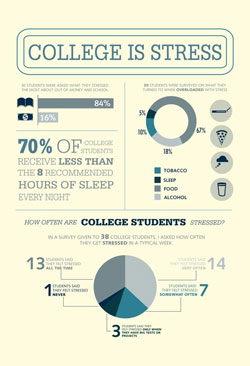When students finally settle into their university, their problems shift from adjusting to college life and preparing for the coming year to more conventional issues that they face on a day-to-day basis. College is a place of learning, socialization and, most of all, growth, but these aspects create problems that every student will have to face in some shape or form.
Whether it be stress from grades, relationships, or even the future they are all working their way towards, college students are under a lot of pressure, and unfortunately it’s usually self-inflicted.
“I think the major struggles facing students are best expressed by the questions racing through their minds: Will I get the GPA I want? Should I even go out tonight? Do my professors even like me? What if I have a fight with my roommate? And so on,” says Liz Roderick, a sophomore psychology major.
“The best way to deal with these things is through good planning, building a strong support system, and remembering that you’re not supposed to know everything about your class material, or about life,” continues Roderick.
It’s true, especially for new students and freshmen, that students will be filled with questions and self-doubt upon their arrival to college, and that’s perfectly normal. By removing the self-inflicted pressure, new students can finally give themselves the chance to flourish at their chosen school.
And what of returning students? Upperclassmen can often be found with even greater stress and uncertainty than new students, and for completely different reasons. Inadequacy, anxiety about the future, and other similar concerns are incredibly common among older students, and it can leave a serious mark on a student’s mind.
“With classes, especially in the arts, you really compare yourself to your peers. And if you see yourself on the lower end of that comparison, you can really feel inadequate. To feel that you are not up to par with your peers, it can either inspire you to do better or demoralize you,” says Rahmonn McMillan, a junior fine arts major.
A much less-seen side to being in a community of your peers, comparing yourself to others can become very disheartening if you fail to see your ability to “stand out” or seem special. And in the end, it sometimes just falls to the student to have faith and keep moving forward. “I’ve been there both ways,” adds McMillan, “but I keep on pushing and I’m getting there.”
There are more than just students at any university, and it’s often the professors’ burden to see countless students come and go, each with their own personal hardships and struggles. Ergo, perhaps the ones best suited to give advice to students are the ever-watchful professors of their university.
“I think, at least in my opinion, one of the bigger challenges is for students to think independently and outside what’s comfortable, and to build on the confidence of being able to do that,” said Diane Zuchnik, an adjunct English professor.
College is a period of growth in the lives of young people, and often going outside of one’s comfort zone is where new skills and triumphs are found. Students will have to be uncomfortable at college if they want to change as people and transform themselves into the person they want to become. Zuchnik adds, “The constant fear of the next step is always looming, for all students. It’s very scary, but in the end, you just have to put one foot in front of the next.”
A recurring theme has presented itself among the people asked about this subject: to keep moving forward. In many students’ experiences, including my own, one scarcely has enough time to focus on an issue or struggle because before long, a new semester complete with new problems has already begun.
Time waits for no one, so if there is any lesson to be learned from contemplating the struggles students go through, it’s that true growth and experience doesn’t always depend on solving any problems that come your way instantaneously.
True growth as a human being comes from moving forward and shouldering on, in order to reach the future that individual wants to see.
IMAGE TAKEN from graphs.net



